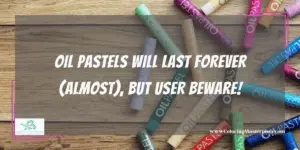Coloring in your adult coloring book using oil pastels is not a choice that should be made without a little careful planning. Because of the oil pastels’ viscosity, using this material can be difficult for your final product to store and preserve. That being said, oil pastels are a terrific medium because they rarely go bad and are reasonably easy to care for and store.
Oil pastels never fully dry, so you should carefully consider how to properly store and care for your final art product when you’re using oil pastels as your chosen medium with adult coloring books. It is all too easy to complete a little masterpiece in your book, close the page, and then open it again to find a smudged and squished artwork! This essential guide will help you consider the careful storage and care of oil pastels—the painting material themselves as well as the final artwork.
Oil pastels will last forever (almost), but user beware!

Consider this: oil pastels are a little bit like painting with lipstick.
-
-
- They are rich, thick, and beautiful when applied correctly.
- They are easy to smudge—whether you want them to or not.
- It’s exciting to create new colors with layering techniques.
- They can create a mess if you don’t store them correctly.
-
Oil pastels are also referred to as a “wax oil crayon.” Oil pastels are made of pigment mixed with (non-drying) oil and a wax-binding agent. Manufacturers of oil pastels differentiate themselves from one another by having more or less of each of those three ingredients and various ingredient types. Some oil pastels are richer and thicker than others, and some oil pastels are physically firmer or softer than other brands. Artists enjoy oil pastels because oil pastels, like oil paints, can create an impasto effect. Impasto is the process or technique of applying paint or pigment thickly to stand out from a surface, giving a rich texture.
Because the oil pastels are always wet, artists use a fixative to keep the paint from smudging. However, most artists using oil pastels are typically working on a canvas to display the painting under glass eventually. Even a fixative applied in multiple layers is not likely to keep the paint from smudging smearing if you close the cover of the book. This is because, again, your oil pastels are always going to remain wet. Keep reading to find out some ways you can store your final painting to minimize smudging!
The good news is that because of their composition; oil pastels are likely to last forever. With few exceptions, oil pastels won’t go wrong on you. For the average artist, unless you accidentally put the crayon in your oven or leave it outside in a desert climate, the oil and wax makeup of the pastel means that it will last for as long as you need it to. That being said, your pigment may fade over time, but that takes a long time and extreme heat/cold conditions for the pigment in the crayon to lose its vibrancy. Keep reading for some tips on caring for your oil pastels.
What do I need to know about fixatives?
Fixatives or sealants are made of acrylic liquid and are applied over a finished oil pastel to provide a barrier between the pastel and the environment. There are two essential things to note here. First, fixatives do not “dry out” your painting and do not make your “ink” dry. Secondly, while the fixative will help protect your painting from smudging, it’s not a cure-all. No matter how many layers of sealant you apply to a painting with many layers of thick pastel applied, the fixative isn’t going to keep your painting from getting smooshed if you close it up in a coloring book and store it on a bookshelf. You can learn more about fixatives and sealants on this website and also on this website.
Three popular manufacturers of fixatives are Talens, Sennelier, and Grumacher. Most fixatives are sold in spray cans, like spray paint. They come in various gloss, semi-gloss, and matte finishes, and some sprays work better for different color pigments than others. If you want to learn more about fixatives, this blog offers a useful at-home test to see what fixative works best in different applications and scenarios.
After you have applied your fixative, you can see how well it worked and whether you need another coat using the fingernail test. Use your fingernail on a nondescript corner of your painting to determine if the pastel is easily smudged or modified by the pressure of your nail. If the pastel moves, then you’ll need another layer of fixative applied.
Interested in another medium? Check out our article on Chalkboard Markers!
How can you care for the final oil pastel painting?

If the “ink” or “paint” never actually dries, what can you do with the final coloring book page to preserve the artwork? Here are a few tips on how you can display and store your artwork.
After extracting the page from the coloring book:
-
-
- Frame the page behind glass. This is the ideal option, as it offers the most security and safety for the artwork itself. When you put it behind glass, you can keep the artwork as chunky as you want with that impasto effect! It’s still good to apply a fixative to ensure the crayon doesn’t stick to the glass frame. Use a double mat to protect the artwork from the glass.
- Put the page into a plastic sleeve. If you’re going to have particularly chunky paint, you will want to apply several layers of good fixative to keep the paint from smashing down. If you’re going to put the page in a plastic sleeve and inside a portfolio or binder, be mindful of smushing. You can prevent this somewhat by putting some foam blocks into the corner of the sleeve.
- Use artist tape to adhere to the page at its corners to an acid-free foam board.
-
If you are going to leave the page in the coloring book or stack the page for storage:
-
-
- Use Glassine or wax paper in front of the page in the coloring book or between each layer if you are stacking the pages. Glassine is a museum-quality paper barrier that will prevent smudging from occurring. You will still want to apply a fixative to your painting. You can find Glassine at your local art store or online.
-
How should I care for my oil pastels?
Oil pastel crayons can get a little dirty over time, accumulating dust and yuckies from inside your storage box, but also dots of pastels from adjacent crayons can get on them. To clean your pastels, use a piece of tissue paper or paper towel and wipe the crayon off. Baby wipes also work well. If there are larger color blemishes on the crayon, scribble on a black page until the blemish has come off. If that doesn’t work, there’s a third trick you can try: use a piece of fine-grained sandpaper to rub the blemish off the crayon gently.
Sometimes you need to take the wrapper off your pastel. You might do this because it accidentally came off. After all, the crayon whittled down in size, or for a variety of other reasons. To protect your fingers from being tarnished with stains, you can wrap your naked crayon with plastic wrap where your fingers will be on the crayon.
To keep bits of color off your crayons in the future, you may want to consider working on how you store the crayons. You’ll want to keep the crayons from touching one another as much as possible. Try storing your crayons together by color. You can keep the crayons apart by using wood dividers (think: popsicle sticks) or foam chunks. I will re-purpose any foam inserts that I’ve gotten from new purchases and carve out small holes in the foam where I can stick my crayons. Check out Pinterest for a variety of innovative storage ideas!
So there you have it! Working with oil pastels takes a little more thought than other types of painting mediums when applied to adult coloring books, but it’s possible to make it work if you plan. There are many benefits to using oil pastels, one of which is that they will last forever and maintain their bright, vibrant hues for years to come if you follow some simple tips to take care of them.
Love coloring as much as I do? Click here to download my free adult coloring eBook and sign up for my email newsletter!
Disclaimer: The information provided by ColoringMasterpiece.com (“The Site”) is for general informational purposes only. All information on the Site is provided in good faith, however, we make no representation or warranty of any kind, express or implied, regarding the accuracy, adequacy, validity, reliability, availability, or completeness of any information on the Site. Under no circumstance shall we have any liability to you for any loss or damage of any kind incurred as a result of the use of the Site or Reliance on any information provided on the Site. Your use of the Site and your reliance on any information on the Site is solely at your own risk. This blog post is for educational purposes only and does not constitute legal advice. Please consult a legal expert to address your specific needs.
Terms and Conditions: https://coloringmasterpiece.com/terms-and-conditions/

